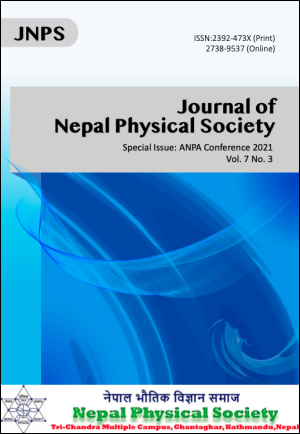A Continuous Time Quantum Monte Carlo as an Impurity Solver for Strongly Correlated System
DOI:
https://doi.org/10.3126/jnphyssoc.v7i3.42185Keywords:
CT-QMC, DFT, DMFT, MIT, Neuromorphic ComputingAbstract
We assess the continuous-time quantum Monte Carlo (CT-QMC) technique with hybridization expansion for solving
the electronic structure of the strongly correlated system LaxSr1−xVO3 . The impurity solver method implemented here shows the fair agreement with the other available Monte Carlo techniques. From the study, it is found that the CT-QMC technique clearly distinguishes metallic phase, quasiparticle phase and insulating phases of the system depending upon the strength of the correlation. In case of La0.33Sr0.67VO3 system the metal-insulator transition is found to be at U = 4.5 eV for β = 6(eV)−1. The value of U depends with the value of β, and also the value of Hund’s coupling (J) and bandwidth (W). This technique allows the particle to exchange with the reservoir of the particles and the impurity sites, which is accounted numerically to treat the temporal fluctuation of the fermionic systems termed as dynamical mean field theory (DMFT). This theory is used to explain the phenomena of MottHubbard metal insulator transition of the materials which are applicable for designing the Mottronics, Neuromorphic computing, Quantum computing and resistive memory devices.
Downloads
Downloads
Published
How to Cite
Issue
Section
License
All right reserved. No part of this Journal may be reproduced in any form or by any electronic or mechanical means, including information storage and retrieval system, without permission in writing from the publisher, except by a reviewer who may quote brief passage in a review. The views and interpretation in this journal are those of author(s) and they are not attributable to the NPS.




